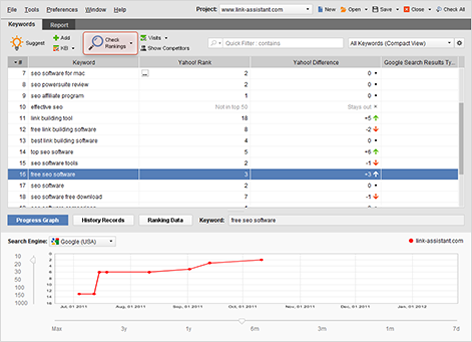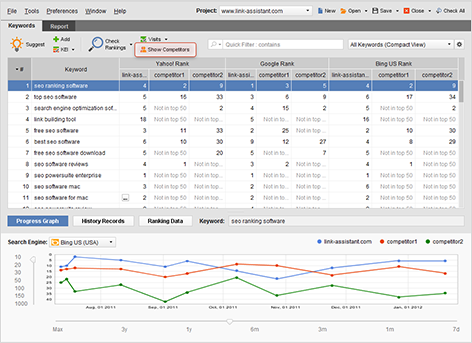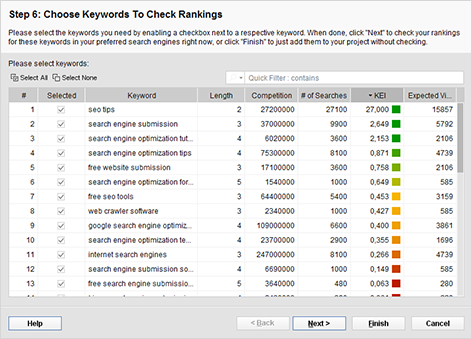Rank Tracker – The First-Class Rank Checker and Keyword Research Tool
Rank Tracker is an advanced rank monitoring tool that gathers a concise report of the ups and downs of your website’s ranking. The app lets you:
- monitor your site rankings performance in over 340 international and local search engines;
- monitor your competitors’ rankings and compare them to yours;
- monitor your and your competitors’ rankings in Google and Bing universal search result blocks: videos, images, news, shopping, places, etc.;
- set any location to collect rankings data for (geo-targeted search);
- keep rankings history of each and every keyword;
- monitor rankings on auto-pilot;
- and more!

 Equipped with 19 keyword research mechanisms, Rank Tracker lets you find a great number of keywords to optimize your website for. Each keyword is analyzed against KEI – the most reliable criteria to identify how SEO-lucrative a keyword is.
Equipped with 19 keyword research mechanisms, Rank Tracker lets you find a great number of keywords to optimize your website for. Each keyword is analyzed against KEI – the most reliable criteria to identify how SEO-lucrative a keyword is. 
 The software also provides you with valuable traffic stats from Google Analytics. With the tools you will learn:
The software also provides you with valuable traffic stats from Google Analytics. With the tools you will learn:
- the number of visitors your keywords are driving;
- bounce rates for each keyword.
On top of that, Rank Tracker lets you analyze PPC data fetched from Google Adwords Keyword Tool. So your PPC and SEO efforts will work together in the most productive way.
Order Now
Rank Tracker
Do you work in a SEO company? Enterprise solutions offers you more possibilities. Best choice for any SEO firm!
Solutions for SEO agencies
- Keyword Difficulty tool in Rank Tracker
- Anti-Penalty Link Audit – now in SEO SpyGlass
- New key social metrics in SEO SpyGlass!
- The ultimate guide to Broken link building

Questions and Answers

Download ‘Rank Tracker‘ addon for Firefox by typing it into google.
Once you’ve installed it, it will show up on the bottom of the browser. Click on it and a window will pop up. Enter your URL and keyword(s) you want to check ranking for. It will list your ranking for Google, Yahoo and Bing.

Simply put, a row of pipes. It is not the same thing as a stop. There are speaking and non-speaking stops. Non-speaking stops include couplers and tremulants.
A speaking stop may be a single rank or multiple ranks. Again, paraphrasing Mr. Jones, mixtures are always multiple ranks (unless derived) and can be as few as two or upwards of ten in large organs. Occasionally, undulating stops such as celestes are two and on very rare occasions three ranks but are usually only a single rank which are tuned either slightly sharp or flat to “beat” against another “companion rank”. These are usually strings or flutes but occasionally foundation ranks are used for this such as the Voce Umana.
A Resultant, Gravissama, Acoustic Bass or Bass d’ Cornet is also a multi rank stop but serves a different function than either the mixtures or undulating stops. It uses differential tones to simulate a stop an octave lower than the pitch of the lowest pipe used in this compound stop. Typically it is of 32′ pitch but examples of 64′ can be found in large organs and I have seen 16′ in a few small practice organs (with limited effect).
Mutations (Aliquot) are single rank stops which can be thought of as color mixtures (as opposed to chorus mixtures) broken down to single rank stops – the Cornet decompose. It is not “de-tuned” but rather it is tuned to perfect intervals rather than the tempered scale. These pitches are usually octaves of fifths and thirds but rare examples are flatted sevenths and major seconds. They conform to the pitches of natural harmonics.
Additionally, a rank may be composed of any number of pipes. Typically 61 for the manuals and 32 for the pedals but exceptions abound. Organs with unified stops will have extended ranks to allow several stops to be derived – 73 pipes, 85 pipes, 97 pipes. Pedal ranks will often have 44 or 56 pipes. There are also short compass ranks, typically found in undulating stops and mutations (49 notes starting at Tenor C) but old, small tracker organs will often have a “Flute Bass” stop of 12 pipes that serves as a common bass with several other short compass ranks. Of course before the standard was set to 61 notes on the manual keyboards and 32 notes on the pedal keyboards a single, straight rank was composed of the number of pipes corresponding to that keyboard, 56 and 30 for example. Another consideration is that many “straight” organs (as opposed to unit organs) will have an extra octane octave of pipes added to the top end of each manual rank. This is commonly called an “extension” and is used so that the organist does not run out of notes when using an octave coupler – thus a 61 pipe rank becomes a 73 pipe rank.
I should also add that on some small organs “synthetic stops” are created by using combinations of other stops wired to a single stop control. An Oboe created from an 8′ flute and a 1 1/3′ for example. There is also a stop called a Kunst Zimble which is composed of several ranks but only has a 12 note compass, repeating over the entire compass of the keyboard. It is used for sparkly, color effects.
So, the first part of your question is simple in essence but gets quite complicated in practice where the second part is also simple but there are details, ifs and and buts.
Fore more information, get yourself a copy of Stevens Irwin’s Dictionary of Pipe Organ stops.




